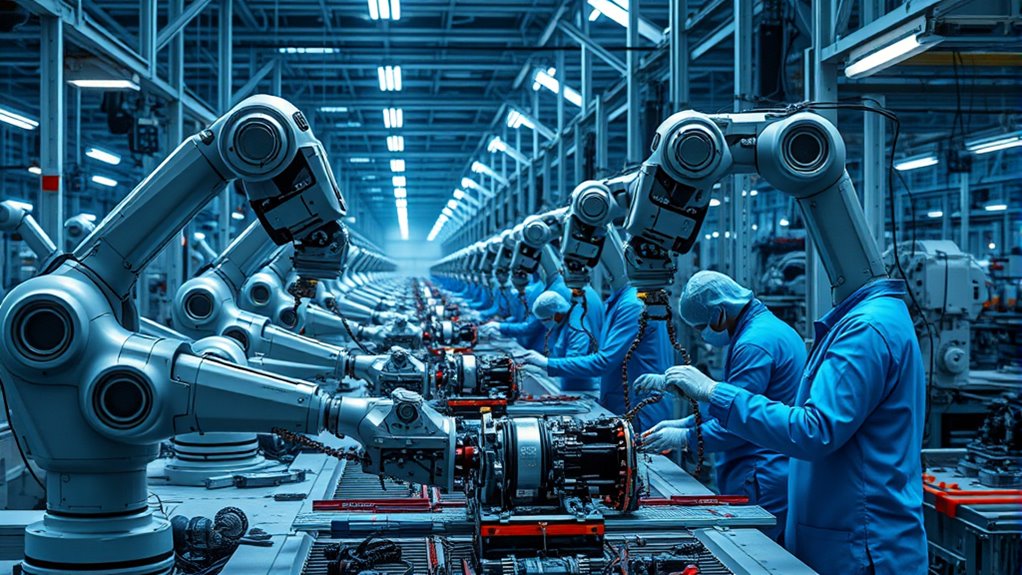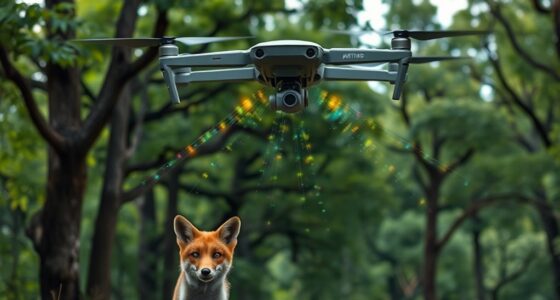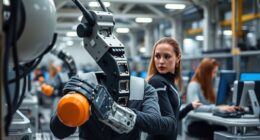AI is revolutionizing factory floors by deploying intelligent machines that boost productivity and quality. These technologies automate routine tasks, enabling faster adaptation to demand and reducing errors. They also improve safety and work conditions by handling physically demanding jobs. While some blue-collar roles may change, AI complements human skills and creates new opportunities. To learn how these innovations shape your industry and workforce, keep exploring the evolving landscape of AI in manufacturing.
Key Takeaways
- AI-driven automation enhances efficiency and quality in blue-collar manufacturing jobs by handling repetitive and physically demanding tasks.
- Intelligent machines enable predictive maintenance, reducing downtime and extending equipment lifespan on the factory floor.
- AI assesses worker skills in real-time, supporting targeted upskilling and personalized training for blue-collar employees.
- Automation can displace routine roles but also creates new opportunities requiring advanced human-AI collaboration.
- Implementing AI fosters safer working conditions by minimizing hazardous manual tasks and promoting hybrid work models.
The Growing Role of AI in Manufacturing Environments
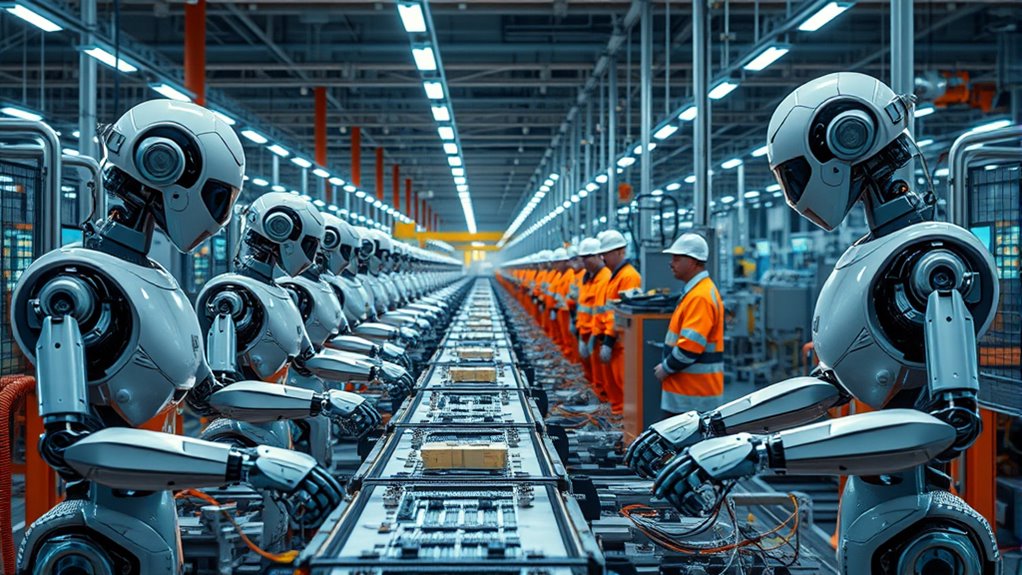
AI is transforming manufacturing environments at an accelerating pace, with more companies adopting these technologies to stay competitive. As of 2024, 35% of manufacturing firms use AI for operational improvements, and the global market is projected to reach nearly USD 231 billion by 2034. AI adoption has surged, with 41% of manufacturers leveraging it to optimize supply chain data. Companies invest heavily in AI programs despite economic challenges, recognizing its potential. Predictive maintenance is a primary focus, with 90% of top machine manufacturers using AI to reduce downtime and costs. AI also enhances quality control, automates defect detection, and streamlines production processes. These advancements lead to increased efficiency, lower costs, and better resource management, making AI an integral part of modern manufacturing.
How Generative AI Is Transforming Product Design and Development
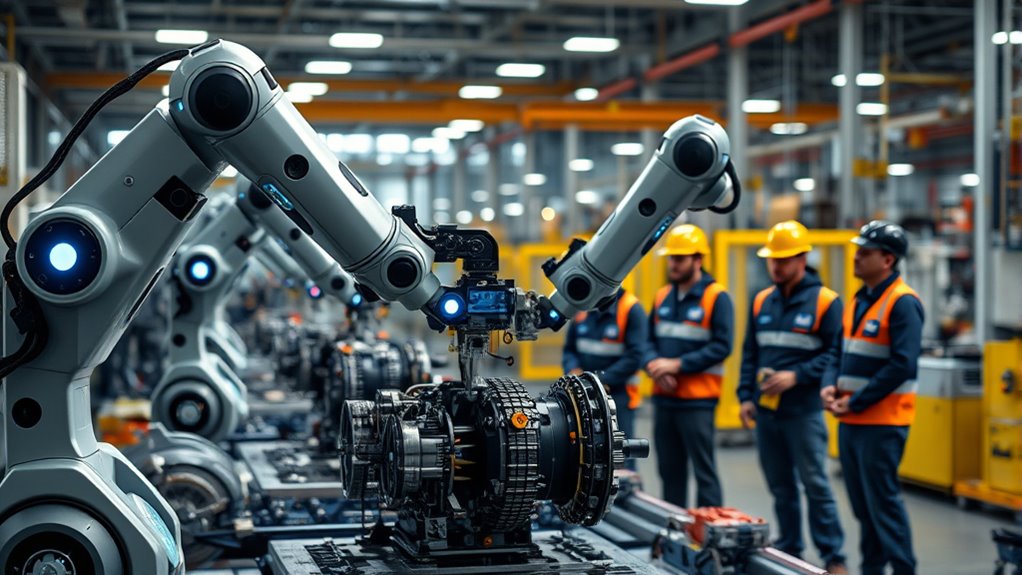
Generative AI is revolutionizing product design by speeding up development cycles and opening new avenues for innovation. It helps you explore multiple design options quickly, improving both cost-efficiency and quality. As a result, you can bring better products to market faster and stay ahead of competitors. Foundation models enable processing large datasets and executing multiple tasks simultaneously, which accelerates the iterative design process and enhances creative exploration. Additionally, these models facilitate real-time data analysis, allowing designers to make informed decisions during the development process.
Accelerating Design Processes
By streamlining the design process, advanced generative tools enable manufacturers to cut product development time by up to 87%, as demonstrated by Eaton’s successful implementation. AI allows you to quickly generate multiple design alternatives based on specific criteria, speeding up decision-making and reducing iteration cycles. It also helps you explore complex design spaces to optimize products for performance, aesthetics, and cost-efficiency simultaneously. Additionally, AI-supported designs tend to be more sustainable, requiring less material and energy, aligning with eco-friendly manufacturing goals. This technology supports natural materials and customization, enabling you to tailor designs to customer needs swiftly. QuantumBlack’s AI tools support this process by facilitating rapid modeling, testing, and refinement, further enhancing efficiency. Leveraging AI-driven insights can also help identify emerging market trends and customer preferences, allowing for more targeted innovation. Incorporating design automation can further accelerate the development cycle and ensure consistency across projects. Furthermore, the integration of recycled materials into design processes exemplifies how sustainable practices are being incorporated into AI-assisted manufacturing, promoting environmental responsibility. The use of butter infusers exemplifies how traditional tools have evolved through technological integration to enhance culinary innovation, illustrating the potential for AI to similarly transform product development. Overall, generative AI shortens design cycles, boosts efficiency, and enhances your ability to innovate faster, giving you a competitive edge in a rapidly evolving market.
Enhancing Innovation Capabilities
Harnessing the power of advanced design tools, manufacturers can now rapidly generate a diverse range of product concepts tailored to specific criteria. Generative AI accelerates design iteration by producing multiple options quickly, enabling you to explore complex design spaces thoroughly. It promotes sustainability by creating designs that use less material and consume less energy, aligning with eco-friendly goals. AI also enables customization, allowing you to swiftly develop and evaluate personalized products that meet individual preferences. These tools spark innovation by suggesting novel solutions that human designers might overlook, expanding creative boundaries. Additionally, understanding prophetic dreams can inspire visionary thinking and open new avenues for creative problem-solving in product development. As a result, your product development process becomes more flexible, collaborative, and data-driven, ultimately boosting your ability to innovate and stay ahead in competitive markets. This technology is transforming how you develop products and redefine industry standards.
Cost and Quality Benefits
Advanced AI tools are revolutionizing the way manufacturers approach product design and development, delivering significant cost and quality benefits. Generative AI reduces material waste by optimizing designs and streamlining production, saving you money. It also cuts costs on physical prototypes by enabling virtual modeling, speeding up iterations. Energy efficiency improves through continuous analysis, lowering utility expenses. Automated planning and design processes cut labor costs and boost workflow efficiency. Plus, AI enhances supply chain management, reducing inventory and logistics expenses. On the quality front, AI fine-tunes product designs based on performance and manufacturing data, ensuring standards are met. Rapid prototyping with 3D printing allows quick refinement, while real-time monitoring identifies issues early. Overall, AI-driven innovations lead to more cost-effective, higher-quality products. Detects defects in real-time using AI further enhances quality assurance by preventing defective products from reaching consumers.
Impact of AI-Driven Automation on Blue-Collar Workforce Dynamics
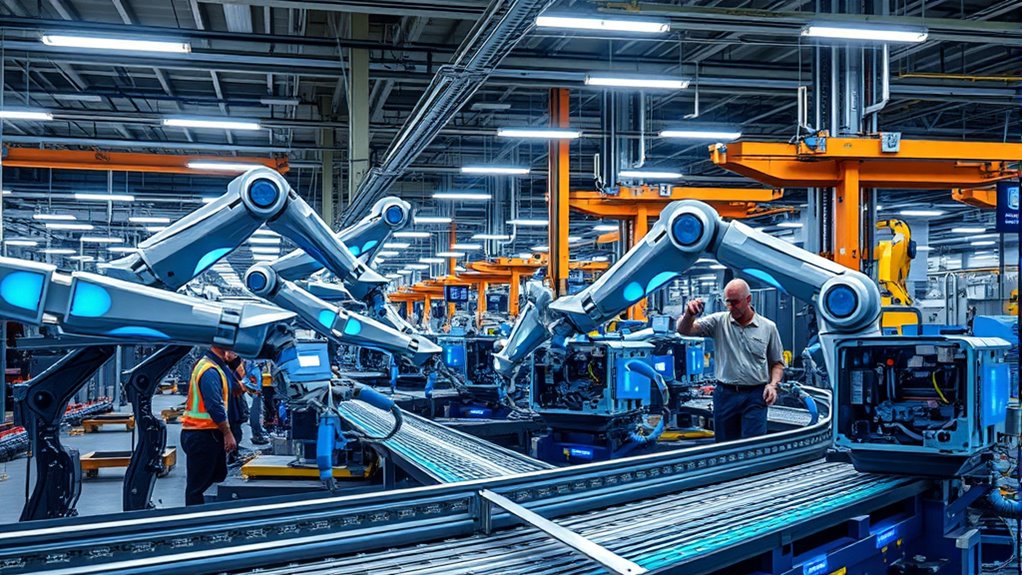
AI-driven automation is transforming blue-collar workforce dynamics by increasing productivity and reshaping job roles on the factory floor. You may face displacement, as up to 75 million jobs could be affected globally, especially in routine tasks. However, automation also creates opportunities:
- New technical roles requiring advanced skills.
- Better working conditions by reducing physically demanding tasks.
- Hybrid models that combine human insight with AI efficiency.
While wages have declined for many, automation pushes workers to upskill to stay relevant. The integration of AI tools and advanced machinery demands continuous learning, but it can also lead to higher productivity. Additionally, adopting a lifestyle mindset that emphasizes ongoing development can help workers adapt more effectively. Understanding the personality traits that facilitate adaptation, such as resilience and openness, can also support a smoother transition. Developing a growth mindset enables workers to view challenges as opportunities for learning and improvement. Recognizing the importance of skilled labor in operating and maintaining automated systems is crucial for future success. Cultivating a mindfulness approach can improve focus and reduce stress during these transitions. Ultimately, your industry is evolving toward a balance where human expertise complements AI, shaping a future workforce with new challenges and opportunities.
Addressing Skills Shortages With Intelligent Machines
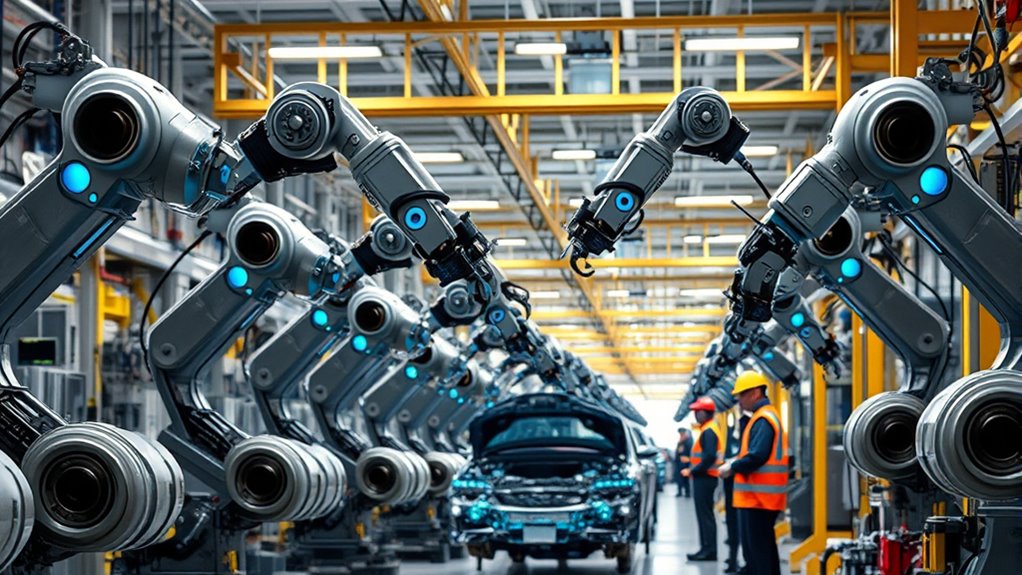
You can leverage intelligent machines to automate repetitive tasks, freeing up your workers to focus on more complex activities. These tools also enhance workforce capabilities by providing real-time support and personalized training. As a result, your team becomes more adaptable and better equipped to meet evolving manufacturing demands. Implementing Ford Tuning techniques can further optimize machinery performance and efficiency on the factory floor. Additionally, integrating personal growth strategies such as stress management and mental clarity can improve overall team productivity and well-being. Incorporating technology adoption strategies can accelerate the integration of these intelligent systems into existing workflows, especially considering how fabric decorating markers influence processing and machine calibration in dairy manufacturing environments.
Automating Repetitive Tasks
Automating repetitive tasks on the factory floor markedly boosts productivity by freeing up human workers to focus on more complex and strategic activities. With automation handling routine work, you can see tangible benefits:
- Increased Efficiency: Tasks are completed faster and more accurately, reducing errors and downtime.
- Enhanced Scalability: Automated systems quickly adapt to higher production demands without extensive manual input.
- Cost Savings: Labor costs decrease as automation minimizes manual labor needs, freeing resources for innovation.
You’ll also find that automating repetitive tasks improves overall quality and consistency through precise, programmed operations. By leveraging AI, robotics, and IoT, you’re transforming your operations into smarter, more agile systems that optimize workflows and reduce reliance on manual labor.
Enhancing Workforce Capabilities
As manufacturing faces a growing skills shortage, integrating intelligent machines helps bridge the gap by enhancing workers’ capabilities. AI-powered platforms assess your skills in real-time, pinpointing strengths and identifying gaps instantly. Predictive analytics forecast workforce needs, enabling better resource allocation and succession planning. Intelligent machines offer personalized learning paths, tailoring training to your unique profile and pace, accelerating skill development. AI continuously optimizes upskilling by recommending targeted improvements based on your performance data and emerging industry demands. Connected tools provide context-aware support during complex tasks, reducing errors and boosting confidence. This integration not only helps you adapt faster to evolving manufacturing technologies but also increases productivity, safety, and job satisfaction—ensuring you’re better equipped for the future of manufacturing.
Opportunities and Challenges of AI Adoption on the Factory Floor
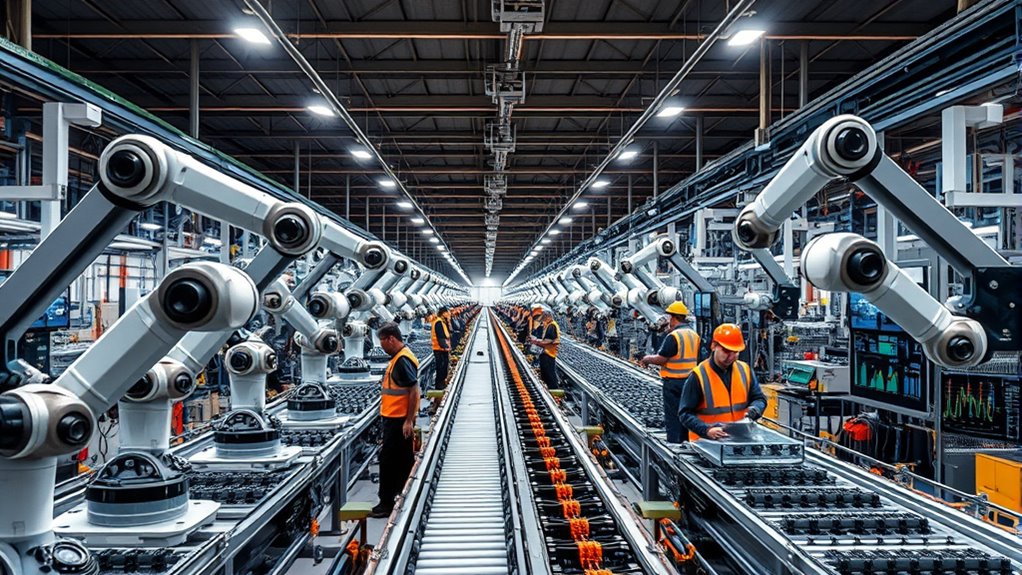
Implementing AI on the factory floor offers significant opportunities to boost efficiency, improve product quality, and cut costs, making manufacturing more competitive and responsive. You can leverage AI to:
- Streamline operations through better supply chain management, predictive maintenance, and quality control.
- Use data analysis to optimize processes and uncover inefficiencies.
- Innovate product design with generative AI, increasing variety and quality.
- Recognize the importance of Real Couples relationships and teamwork, which can serve as a model for collaborative efforts in AI integration and workplace harmony.
Additionally, fostering a collaborative environment can help mitigate resistance to change and promote smoother AI adoption. Emphasizing workplace culture and employee engagement is essential for successful integration. Building a strong digital infrastructure is also crucial to support AI deployment and real-time data processing effectively.
However, challenges exist. You’ll face technical complexity in integration, security concerns with data, and high upfront investments. Data quality is critical; poor data hampers AI’s effectiveness. While over 70% of manufacturers plan AI adoption, job displacement remains a concern. Balancing these opportunities and challenges is key to successful AI implementation on your factory floor.
Future Trends: Advancing Efficiency and Innovation Through AI
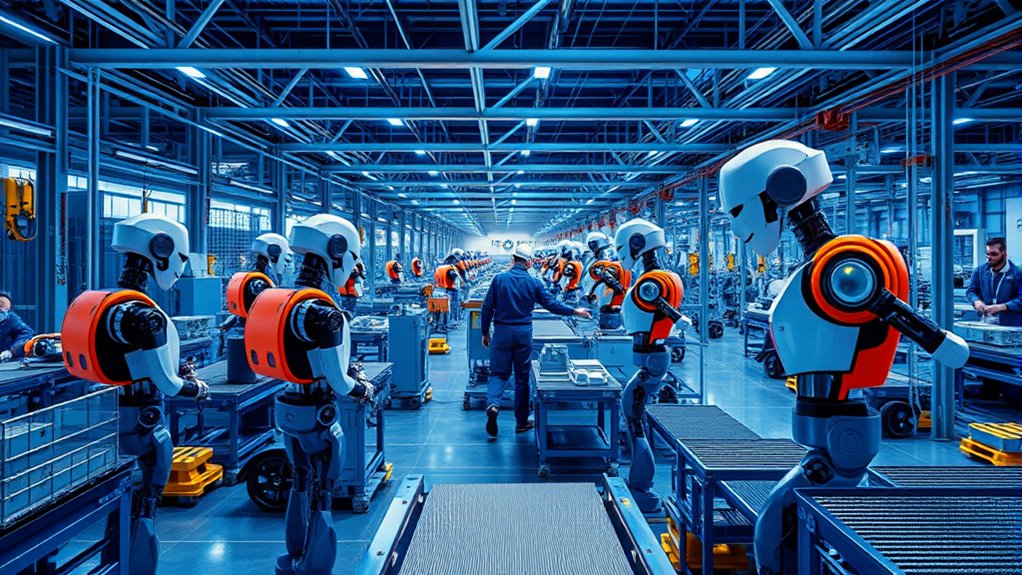
Advancements in AI are shaping the factory floor by driving greater efficiency and fostering innovation. You’ll see up to 50% reduction in forecasting errors, helping you better match production to demand, cutting excess inventory and shortages. Predictive maintenance powered by AI can slash machine downtime losses by half, boosting equipment uptime and productivity. AI supports “lights-out” manufacturing, enabling 24/7 operations with minimal human oversight. Real-time sensors allow for anticipatory repairs, extending equipment lifespan and preventing costly breakdowns. Additionally, AI-powered vision systems catch defects in real time, improving quality and reducing rejects. On the innovation front, over 60% of new products will incorporate generative AI by 2025, accelerating design cycles. Monitoring machine conditions and maintenance needs through AI-driven insights can further optimize operational efficiency. Incorporating advanced tuning techniques from automotive applications can also inspire smarter adjustments to manufacturing processes, making your factory smarter, more responsive, and capable of continuous innovation. Furthermore, understanding regional labor trends can help tailor AI deployment strategies to maximize workforce benefits and adapt to local market conditions. Integrating insights from Honda Tuning can lead to more precise control and customization of manufacturing parameters, ultimately enhancing overall production quality and flexibility.
Frequently Asked Questions
How Does AI Impact Safety Protocols on Manufacturing Floors?
You see AI’s impact on safety protocols through real-time monitoring, predictive maintenance, and automated responses. AI collects data via sensors, detects hazards early, and sends instant alerts to prevent accidents. It predicts machinery failures, schedules maintenance, and enables quick emergency shutdowns. These actions help you reduce risks, improve safety measures, and create a safer work environment, ultimately minimizing hazards and protecting workers on the manufacturing floor.
What Training Is Needed for Workers to Operate Ai-Enabled Machinery?
Did you know 85% of manufacturing workers believe AI will transform their jobs? To operate AI-enabled machinery, you need basic AI literacy—understanding its principles, capabilities, and limitations. You should learn how to input data, interpret AI insights, and follow safety protocols. Hands-on practice and role-specific training, including AR or VR, help build confidence. Continuous upskilling guarantees you stay current with evolving AI technologies, making you more effective and safe on the factory floor.
Are There Legal or Ethical Concerns With AI Replacing Human Jobs?
You might worry about legal and ethical issues when AI replaces human jobs. Legally, safety standards, liability, and data protection are key concerns, while ethically, job displacement, privacy, bias, and fairness come into play. You should consider how AI impacts workers’ rights and societal inequality. Addressing these concerns involves updating laws, ensuring transparency, and promoting ethical AI development to protect workers and foster trust.
How Do Factories Ensure Data Security With Increased AI Integration?
Imagine your factory’s secrets slipping through your fingers—data breaches threaten everything. To prevent this, you need a robust security framework. You implement strict policies, adopt zero-trust models, and encrypt data from the start. Regular assessments, role-based access controls, and continuous monitoring keep threats at bay. Collaborate across departments and stay compliant. These proactive steps guarantee your AI systems stay secure, protecting your factory’s future from unseen dangers.
What Are the Cost Implications of Adopting AI in Manufacturing?
When you adopt AI in manufacturing, you face significant costs. Implementation expenses have surged, reaching around $190,000 for custom solutions, with industry-specific development costs often between $400,000 and $800,000+. You need to allocate funds for data infrastructure, cybersecurity, and ongoing maintenance. While AI can cut process costs by up to 30%, covering initial investments and long-term upkeep requires careful planning to guarantee a positive return on investment.
Conclusion
As you see, AI is reshaping the factory floor, making processes smarter and more efficient. It’s changing how you work, opening new opportunities, but also raising questions about the future of blue-collar jobs. Are you ready to embrace these intelligent machines and harness their potential? As technology advances, your role will evolve—will you be prepared to thrive in this new era of manufacturing innovation? The future is now, and it’s waiting for you to lead the change.
